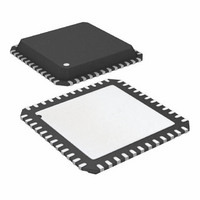AD9511BCPZ Analog Devices Inc, AD9511BCPZ Datasheet - Page 21

AD9511BCPZ
Manufacturer Part Number
AD9511BCPZ
Description
IC CLOCK DIST 5OUT PLL 48LFCSP
Manufacturer
Analog Devices Inc
Type
Fanout Buffer (Distribution), Divider, PLLr
Datasheet
1.AD9511BCPZ.pdf
(60 pages)
Specifications of AD9511BCPZ
Number Of Circuits
1
Ratio - Input:output
2:5
Differential - Input:output
Yes/Yes
Input
Clock
Output
CMOS, LVDS, LVPECL
Frequency - Max
1.2GHz
Voltage - Supply
3.135 V ~ 3.465 V
Operating Temperature
-40°C ~ 85°C
Mounting Type
Surface Mount
Package / Case
48-LFCSP
Frequency-max
1.2GHz
Clock Ic Type
Clock Distribution
Ic Interface Type
Serial
Frequency
1.2GHz
No. Of Outputs
5
No. Of Multipliers / Dividers
5
Supply Voltage Range
3.135V To 3.465V
Lead Free Status / RoHS Status
Lead free / RoHS Compliant
For Use With
AD9511/PCB - BOARD EVAL CLOCK DISTR 48LFCSPAD9511-VCO/PCB - BOARD EVAL CLOCK DISTR 48LFCSP
Lead Free Status / RoHS Status
Lead free / RoHS Compliant, Lead free / RoHS Compliant
Available stocks
Company
Part Number
Manufacturer
Quantity
Price
Company:
Part Number:
AD9511BCPZ
Manufacturer:
ADI
Quantity:
139
Part Number:
AD9511BCPZ
Manufacturer:
ADI/亚德诺
Quantity:
20 000
Part Number:
AD9511BCPZ-REEL7
Manufacturer:
ADI/亚德诺
Quantity:
20 000
TERMINOLOGY
Phase Jitter and Phase Noise
An ideal sine wave can be thought of as having a continuous
and even progression of phase with time from 0 degrees to
360 degrees for each cycle. Actual signals, however, display a
certain amount of variation from ideal phase progression over
time. This phenomenon is called phase jitter. Although many
causes can contribute to phase jitter, one major cause is random
noise, which is characterized statistically as being Gaussian
(normal) in distribution.
This phase jitter leads to a spreading out of the energy of the
sine wave in the frequency domain, producing a continuous
power spectrum. This power spectrum is usually reported as a
series of values whose units are dBc/Hz at a given offset in
frequency from the sine wave (carrier). The value is a ratio
(expressed in dB) of the power contained within a 1 Hz
bandwidth with respect to the power at the carrier frequency.
For each measurement, the offset from the carrier frequency is
also given.
It is meaningful to integrate the total power contained within
some interval of offset frequencies (for example, 10 kHz to
10 MHz). This is called the integrated phase noise over that
frequency offset interval and can be readily related to the time
jitter due to the phase noise within that offset frequency
interval.
Phase noise has a detrimental effect on the performance of
ADCs, DACs, and RF mixers. It lowers the achievable dynamic
range of the converters and mixers, although they are affected
in somewhat different ways.
Rev. A | Page 21 of 60
Time Jitter
Phase noise is a frequency domain phenomenon. In the time
domain, the same effect is exhibited as time jitter. When
observing a sine wave, the time of successive zero crossings is
seen to vary. In a square wave, the time jitter is seen as a
displacement of the edges from their ideal (regular) times of
occurrence. In both cases, the variations in timing from the
ideal are the time jitter. Since these variations are random in
nature, the time jitter is specified in units of seconds root mean
square (rms) or 1 sigma of the Gaussian distribution.
Time jitter that occurs on a sampling clock for a DAC or an
ADC decreases the SNR and dynamic range of the converter.
A sampling clock with the lowest possible jitter provides the
highest performance from a given converter.
Additive Phase Noise
It is the amount of phase noise that is attributable to the device
or subsystem being measured. The phase noise of any external
oscillators or clock sources has been subtracted. This makes it
possible to predict the degree to which the device impacts the
total system phase noise when used in conjunction with the
various oscillators and clock sources, each of which contribute
their own phase noise to the total. In many cases, the phase
noise of one element dominates the system phase noise.
Additive Time Jitter
It is the amount of time jitter that is attributable to the device
or subsystem being measured. The time jitter of any external
oscillators or clock sources has been subtracted. This makes it
possible to predict the degree to which the device will impact
the total system time jitter when used in conjunction with the
various oscillators and clock sources, each of which contribute
their own time jitter to the total. In many cases, the time jitter of
the external oscillators and clock sources dominates the system
time jitter.
AD9511














